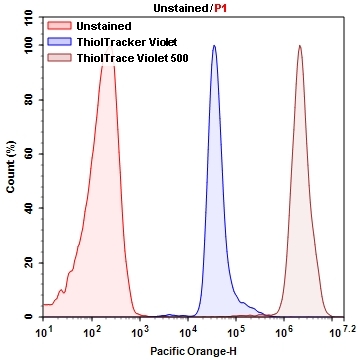ThiolTrace™ Violet 500
The subcellular detection and localization of GSH is important in understanding the modulation of redox status, the effect of drugs, and the mechanisms of detoxification. ThiolTrace™ Violet 500 is a brighter and more robust intracellular thiol probe for monitoring intracelluar GSH than the commonly used mBBr, mBCl or Thiotracker™ Violet. Since reduced glutathione represents the majority of intracellular free thiols in the cell, ThiolTrace™ Violet 500 can be used in estimating the cellular level of reduced glutathione. It is at least 10X brighter than mBCL and other intracellular common thiol detection probes (e.g., Thiotracker Violet), and can be excited with UV or 405 nm excitation with a large Stokes shift. It can be fixed with aldehydes and permeabilized by Triton® X-100 (0.5%). It may be used in multiplex assays including cytotoxicity studies. ThiolTrace Violet 500 provides a simple, sensitive and reproducible tool to detect reduced GSH content in biological samples. ThiolTrace Violet 500 reacts with thiol to emit a strong fluorescence of 520-530 nm with excitation at the common violet 405 nm laser. When compared with ThiolTracker Violet (Thermo Fisher Scientific), ThiolTrace Violet 500 has 10-100 fold higher intensity in cell culture medium containing growth factors. ThiolTrace Violet 500 is compatible with wide variety of diluents including serum containing cell culture medium. ThiolTrace™ Violet 500 can be used for Flow Cytometry, HCS imaging and epifluorescent microscopy.


| Catalog | Size | Price | Quantity |
|---|---|---|---|
| 22280 | 500 Tests | Price |
Physical properties
| Molecular weight | 557.01 |
| Solvent | DMSO |
Spectral properties
| Excitation (nm) | 415 |
| Emission (nm) | 499 |
Storage, safety and handling
| H-phrase | H303, H313, H333 |
| Hazard symbol | XN |
| Intended use | Research Use Only (RUO) |
| R-phrase | R20, R21, R22 |
| Storage | Freeze (< -15 °C); Minimize light exposure |
| UNSPSC | 12352200 |
Instrument settings
| Flow cytometer | |
| Excitation | 405 nm laser |
| Emission | 525/50 nm filter |
| Instrument specification(s) | Pacific Orange channel |
| Fluorescence microscope | |
| Excitation | 405 nm |
| Emission | 525 nm |
| Recommended plate | Black wall/clear bottom |
| Instrument specification(s) | TRITC filterset |
Contact us
| Telephone | |
| Fax | |
| sales@aatbio.com | |
| International | See distributors |
| Bulk request | Inquire |
| Custom size | Inquire |
| Technical Support | Contact us |
| Request quotation | Request |
| Purchase order | Send to sales@aatbio.com |
| Shipping | Standard overnight for United States, inquire for international |
Page updated on January 8, 2026

